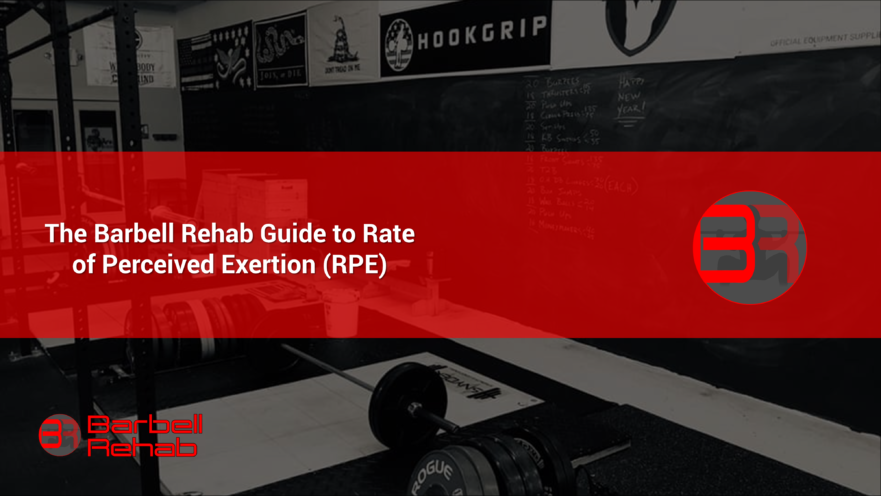If you’re a barbell athlete who’s interested in improving strength, you should familiarize yourself with RPE. Why? Because RPE, or rate of perceived exertion, is a great way to optimize your training and manage fatigue. So here’s the official Barbell Rehab Guide to RPE.
What is RPE?
RPE is a way to rate how “difficult” a set felt to YOU. It is a measure of relative intensity, which is different from absolute intensity, or the amount of weight that’s on the bar.
For example, a 225 lb squat will ALWAYS be 225 lbs. (absolute intensity), but on some days it may FEEL more difficult (relative intensity) than others. Both the absolute and relative intensity are important variables we measure during programming.
How to Rate RPE
The RPE scale we use for barbell training is a scale from 1-10. This is different from the Borg RPE scale which goes from 6-20, and is more common in the medical community, as it can correlate with heart rate.
To rate RPE after a set, you want to think about how many more reps you could have done, and this will correlate with a specific RPE. For example, if you squatted 5 reps, but could have done 1 more, this would be rated as a RPE 9. If you could have done 2 more reps, that would be an RPE 8/10.
With RPE, you can also utilize half steps or increments of 0.5. This can help further manage fatigue and loading. For example, an RPE of 9.5 means you MIGHT have been able to do one more rep. An RPE of 8.5 means you DEFINITELY had one more rep, and POSSIBLY two more reps. For more detailed information regarding this guide to RPE, take a look at the chart below.

Why Should You Use RPE?
Why would a 225 lb squat feel “heavier” on one day vs. another. How heavy a weight feels can be influenced by the amount of sleep you’ve been getting, your diet, and your overall stress levels. Spend all night partying and only get 3 hours of sleep? Yeah…that weight may feel pretty heavy the next day, or be at a high relative intensity, despite it being a moderate absolute intensity.
Why is this important? If you’re an intermediate or advanced lifter who is selecting training loads based on RPE (more on this later) it may behoove you to work at a lower absolute intensity on these days to ensure you’re not working at too high of an RPE (relative intensity).
Training With RPE vs. Assigning RPE After the Set
There are two ways that you can train utilizing RPE. First, you can train with a specific load and then rate the RPE after the set, or you can train at a specific RPE to determine the load lifted for that training session.
For beginner lifters, I recommend training at a pre-determined LOAD and simply practicing your ability to rate RPE. Why? Because just like any other skill, the ability to accurately assign an RPE takes practice, so the loads you chose as a beginner lifter should NOT be based on RPE.
A true novice lifter should be increasing the weight on the bar every session anyways, so there’s no need to select the load via RPE. This, instead, will serve as a prime opportunity to familiarize yourself with RPE and get really good at working with it.
For intermediate and advanced lifters who are no longer able to linearly progress intensity, assigning the load based on the RPE can be a valuable tool. By choosing a load based on the RPE, this can ensure that you’re not working at too high of a relative intensity on days that you are experiencing higher stress and fatigue. It also allow you to push things harder on days that you’re more well rested and experiencing lower stress.
Using RPE to Return from an Injury
RPE can also be a great tool to utilize when returning from an injury. When returning from an injury, I recommend starting at a load that is significantly LOWER than your current capacity. This is usually around and RPE 5. Once the RPE of your working sets are consistently around an 8.5-9, this would then warrant a programming change to drive further progress, but reduce injury risk. For more information about how to do this, download our 4-Step Framework to Training with Pain.
So whether you’re new to training, or someone who has years under your belt, you can now use this guide to RPE as a valuable tool in helping you achieve your strength goals.

